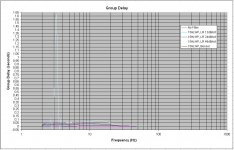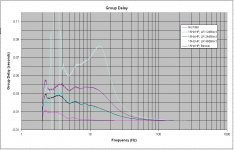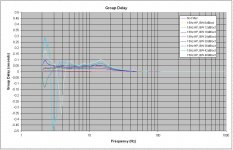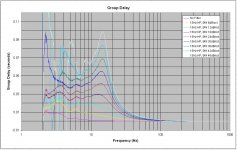Indeed: Gibb's oscillations reproduced through a FIR-filtered test CD for example are symetrical about the transition:Well, it's a philosophical matter, but the fact is that the click marking the start of the kick drum event is heard with a certain pre-ring or 'reverse reverb' in the case of a linear phase filter, even after latency is compensated. So that's a violation of causality in the sense it can't happen naturally.
File:SquareWave.gif - Wikipedia, the free encyclopedia
It was a figure of speech. I love killing problems when they are already dead.You are right.
Now I will try to extract the GD from the phase data.
I managed to extract Group Delay data from the Phase data.
I hope that I am not far off with the time units. Please cross check what I show you (*)
I know that I forget a lot as I am getting older but I become scared when I see the confirmation of it.I would like to read Tom Danley’s opinion on this, as he has been involved in producing a lot of LFs and some good amounts of VLFs for some decades. He should have noticed something by now!
Tom had given his opinion on GD but I forgot I had read it here:
Hi Guys
For loudspeakers anyway, I have not found GD to be particularly useful as a tool.
George
(*) Waly you have a sw tool that plots GD of filters, yes?
Attached is the gain (red), phase (blue) and group delay (green) of a 3rd order Sallen-Key high pass filter, tuned at some 18Hz. Group delay is one order of magnitude higher than your target.
Attachments
Ohh. I thought that the delay between preringing and the main event was actually the latency (plus some delta-T).
Jan
That explanation leads to problems, the pre-ringing is mandated by the math the latency can be an artifact of the implementation.
>pre-ringing is mandated by the math.....................
>the latency can be an artifact of the implementation.
Beware hardware guys ?
Just say'in if you chose a filter with sin(x)/x response it doesn't matter how fast you compute the result you get the pre-ringing.
Request: for the sake of earnest students, can we change the language from "Sallen-Key" to "active R-C filter"? Using the S-K is misleading---there are any number of active filters (or for that matter, passive L-R-C ones with appropriately specified terminations in and out) that have precisely the same response. The is nothing special about Sallen-Key topologies, other than various characteristics unrelated directly to filter transfer functions.
Sorry, pet peeve, like appending "nonlinear" to practically everything. Or the misuse of the term "linear beta", when what is meant is constant beta.
Sorry, pet peeve, like appending "nonlinear" to practically everything. Or the misuse of the term "linear beta", when what is meant is constant beta.
Just say'in if you chose a filter with sin(x)/x response it doesn't matter how fast you compute the result you get the pre-ringing.
Scott please humor me, this is hard for me. Am I correct to assume that the pre-ringing occurs (immediately) after the signal enters the filter/DSP?
And that the 'main signal' occurs after that? Which most probably has no direct relation to latency as I thought, latency being an independent delay through the system caused by compute time required?
Jan
There is the good and bad -
The good - They won't be outright rude to you (like in NY).
The bad - It's harder to figure if you actually have offended (they won't tell you).
Once you "reckon" these "ways" , be able to slow down - take it easy ....
the better aspects (the food and friends) become available.
OS
I can relate to that - about the same as in local rural societies. Of course, no two rural societies are the same, some local specifics always apply, and one does have to get the hang of them.
It's the hospitality which gets you, NOTHING like in the big cities. Way back in '69, my uncle, aunt and myself drove well into Virgian. Along the way, we stopped to ask a local farmer where could we fire up our portable grill and not break any laws, and he sadi, sure, take the first trun to the right, that's my farm, and make yourselves at home. Later on, he dropped by for a chat, then his kids also came along and had themselves a piece of cake my aunt brought, daddy was none too pleased with it, but we smoothes things over, kids are kids, bless them. Even his dog walked over to introduce himself and got a T bone. All in all, I enjoyed the experience, very friendly, and upon hearing where we were from, the farmer seemed very plaesed we stopped at just his place. A very fine memory undeed. Of course, we cleaned up after ourselves.
This was well known at those times. A colleage of my dad's from Ankara, Rick Thompson, got stuck in Serbia on his way from the UK to Ankara, He drove a Rambler, which left him by the roadside like 40 miles from the nearest bigger town. A local farmer drove his horse cart by the wayside, asked what was the matter (God alone, if He, knows how they communicated, probably arms and legs), and the afrmer picked him up. He took Rick to his house, a humle abode, and refused to take him to the local motel, "because they are swindlers". So Rick spent the wined and dined as a house guest, and spent the night there. In the morning, his car was towed to a local workshop, which found what was wrong and told Rick they could jury rig it for him just to get home, but his first job at home would be to get the car to a service station with proper parts. And so it was, he made it back in just one day, to Istanbul, where he had the car properly repaired. He was amazed that despite his insistence, he simply could not make the farmer take any money.
That was then - today, when we are a much more modern society, he would probably be a victim of some roadside vulture dying to tow him and skin him, typically charging him €2 per towed kilometre, when the automobile club charge is just €0,65 per towed kilometre.
It was a figure of speech. I love killing problems when they are already dead.
No problem is ever dead enough?
No worries, yes,yes, no to the 3 questions. Say the linear phase filter is real time, and at t=0 there is a unit impulse. The output of the filter in time after t=0 is a symmetrical waveform, beginning with a pre-ring, then a broadened peak, then a post-ring.Scott please humor me, this is hard for me. Am I correct to assume that the pre-ringing occurs (immediately) after the signal enters the filter/DSP?
And that the 'main signal' occurs after that? Which most probably has no direct relation to latency as I thought, latency being an independent delay through the system caused by compute time required?
Jan
The peak occurs at a time after t=0, known as 'latency', depending on the implementation of the filter. So, relative to the audible location of the filtered peak, the pre-ring appears to occur before it in time.
This thread seems to confirm-it brilliantly.No problem is ever dead enough?
Nope. The cause of the pre-ring is an artefact of linear phase filters, and these have zero group delay by definition. If you like, it's the mathematical penalty for zero group delay. From a listening perspective, say listening to a single click, causality is offended by the pre-ring, which can sound like impossible reverse reverb eg in the (most excellent) video I already linked on this thread with a clear audio demo.So basically pre-ringing occurs due to latency and GD at LF. Therefore causality is preserved. Is that right?
No way is the filtering of vinyl sub audio a 'dead' problem, BTW !
Yes it is. As you confirmed. Measure the LF ringing of your arm resonance. Set an analog active notch filter with the same resonance frequency and Q. Flat response curve, 0 group delay there.No way is the filtering of vinyl sub audio a 'dead' problem, BTW !
Nothing but a pure audiophile reproduction, with surface noise, cracks, distortions, accidents in the response curve, and colorations or character that you can adjust to your taste, just by changing the head.
Last edited:
Nope. The cause of the pre-ring is an artefact of linear phase filters, and these have zero group delay by definition. If you like, it's the mathematical penalty for zero group delay. From a listening perspective, say listening to a single click, causality is offended by the pre-ring, which can sound like impossible reverse reverb eg in the (most excellent) video I already linked on this thread with a clear audio demo.
No way is the filtering of vinyl sub audio a 'dead' problem, BTW !
Lucky thanks for both posts.
But I do find this 'pre-ringing causality-violation' misleading. The pre-ringing does not occur in real time before the impulse that causes it. You might as well say that charging a cap with a current impulse violates causality because, seen from the cap, the current into the cap occurs before the voltage on the cap.
Jan
You're welcome, Jan. I get what you say. It's a philosophical thing, but if only listening to the filtered output, the pre-ring happens before the click which caused it. Which is unnatural, and I think William James might say, pragmatically, 'is the same as a violation of causality' because it is indistinguishable from it to the observer.Lucky thanks for both posts.
But I do find this 'pre-ringing causality-violation' misleading. The pre-ringing does not occur in real time before the impulse that causes it. You might as well say that charging a cap with a current impulse violates causality because, seen from the cap, the current into the cap occurs before the voltage on the cap.
Jan
(*) Waly you have a sw tool that plots GD of filters, yes?
Just a standard function in pspice, calculates the GD as -d(Phase(w))/d(w)
Yes........BUT you then need a filter with the following freq and (minimum) phase response (see attached plot).Yes it is. As you confirmed. Measure the LF ringing of your arm resonance. Set an analog active notch filter with the same resonance frequency and Q. Flat response curve, 0 group delay there.
And the problem a decade below the resonant frequency is obvious, +40dB gain at c 1Hz......just don't slam the door !
- Status
- Not open for further replies.
- Home
- Member Areas
- The Lounge
- John Curl's Blowtorch preamplifier part II



